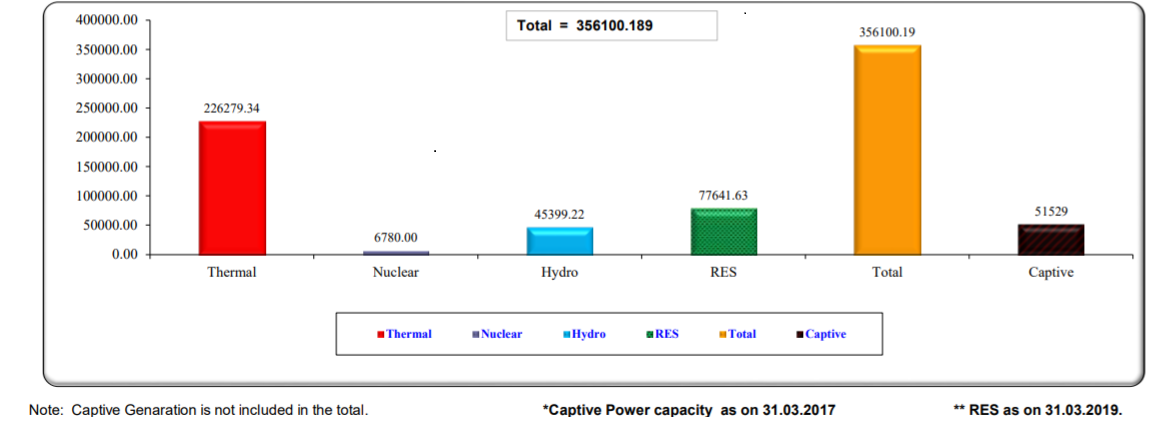How clean power can help us to breathe cleaner air
As per the Central Electricity Authority’s (CEA) Executive Summary for April 2019, India has close to 200 GW of installed capacity of coal and lignite power plants. This corresponds to close to 56% of the country’s installed capacity. In terms of number of units of electricity generated, coal and lignite contributed close to 82% of the electricity generated in the period 1 April 2018 – 31 March 2019.
 All India installed capacity (MW) Region-wise as on 30-4-19; CEA, Generation Report for April 2019
All India installed capacity (MW) Region-wise as on 30-4-19; CEA, Generation Report for April 2019
However, thermal power plants have also been identified as one of the 17 categories of highly polluting industries under the Water Act, 1974 and Air Act, 19811. Research by NASA and the University of Maryland has indicated that India’s sulphur-di-oxide (SO2) emissions have increased by 50% in the period 2005-2016. According to the U.S. Environmental Protection Agency (EPA), the largest contributor of SO2 in the atmosphere is the burning of fossil fuels by power plants and other industrial facilities. This gas is harmful for humans, causing respiratory problems as well as reducing green cover in the environment. But barring a few, most of India’s thermal plants are located away from our cities; and hence the health impacts of the air pollution caused by these power plants have escaped the eyes and lungs of policy makers.
But several communities living near power plants have felt the effects of these harmful pollutants on their health and livelihoods. The Coastal Resource Centre, acting on complaints from local residents and fisherfolk conducted a study in 2016 around the thermal power plant cluster in Ennore, Tamil Nadu. The research revealed that the recorded particulate matter (PM2.5) was several times more than the standards prescribed by the Ministry of Environment Forests and Climate Change (MOEFCC). [India’s standards are lower than US Environment Protection Agency (EPA) standards, where these results would have issued an advisory for unhealthy air quality.] The report further found very high levels of other toxic metals including Arsenic, Manganese, Lead and Nickel. [Importantly, except for Arsenic, there are no limits specified in India for the other three elements.]
In 2018, the MOEFCC finally notified standards related to air quality that need to be adhered to by thermal power plants. (Environment (Protection) Amendment Rules, 2018). The standards must be met by 2022, by all thermal power plants. In addition, largely in response to sustained environmental campaigns and health studies, the MOEFCC issued an office memorandum dated 19th November 2018 titled “Standardisation of Conditions to be stipulated in the Environmental Clearance for Thermal Power Projects”. In this, there is a much needed inclusion of issues pertaining to the “Human Health Environment” including, bi-annual health check-up of all thermal power plant workers, baseline health assessment of residents in the surrounding area, impact assessment on nearby agricultural crops and large water bodies; and assessing impacts due to heavy metals’ emission.
These are measures that will reduce the gravity of the impact, not eliminate them. Even if all the measures are implemented in full, it will only happen by 2022; implying that communities like the one in Ennore, will continue to be exposed to these dangerous pollutants for an extended period of time. Even though newer coal plants (under construction or planned) are expected to be less polluting than the existing fleet, we need to consider how much more pollution from thermal power plants our country can afford. Instead, we should turn to less polluting renewable energy technologies.
In addition to directly addressing air pollution from thermal power plants, shifting to a more aggressive renewable energy pathway will also help India achieve its global climate targets. However, planning and deployment of an increased renewable energy future in India will need more work – crucially on the energy storage front to make it an economically viable solution. As the Indian economy continues to grow, we will need a combination of strict enforcement of environmental standards on all thermal power plants and an accelerated push towards energy efficiency, renewable energy and storage deployment that will help our current and future generations breathe cleaner air tomorrow.
-
Central Pollution Control Board (CPCB) Direction issued under Section 18(1)(b)/31-A to all SPCBs and PCCs. ↩︎